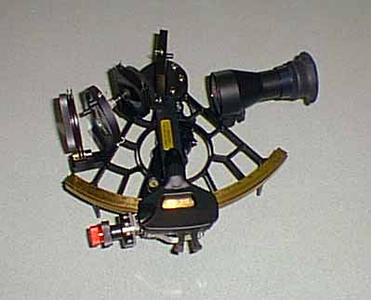21 February, 1999
February 21, 1999
Greetings from the N.B.P! Today we finished our last seismic line in the Ross
Sea. Tonight and tomorrow, we will be multibeaming and collecting
piston/trigger cores along today's seismic line. After that, we’re going
to be
transiting to our next location. The ETs (electronic technicians) are making
progress on fixing our side scan sonar (the fish). Today, we even put it in
the water to try it out. It still needs a little work, but we are getting
optimistic! The goal is to put it back in the water later tonight. Can you
imagine trying to fix everything that broke around your home without going to
the store to pick up the parts that you need? In addition, I think it would
extremely difficult to fix things while on a moving ship that is rolling back
and forth!
Let's take a few minutes to look at yesterday's questions. They were, "What
methods could we use to determine our location?" and "How do these methods
compare to what the earliest Antarctic explorers used?" On the Nathaniel B.
Palmer, we use GPS to figure out our exact latitude and longitude. GPS stands
for Global Positioning System, and it uses satellites that are up in space.
Currently, there are at least 24 GPS satellites going around the Earth. To
determine your position, you need to be able to receive information from at
least three satellites (the more satellites, the more accurate your
information). If you want to learn your elevation too, you need information
from at least four satellites. These satellites send out information
including
which satellite you are using and the time that the signal was sent. Receivers
on the ship use that information to calculate how far the satellite is from
the
ship (we know that the information travels at the speed of light). With at
least three points, the receivers use triangulation to determine the ship's
exact location. On this ship, we receive an update on our exact latitude and
longitude every second. This information appears on our television screens
where we are able to monitor all of the equipment. We do not have to use the
GPS system manually -- we take our navigation for granted This method of
determining location is used by people all over the world. It is not just
used
for the navigation of ships.
The earliest explorers didn't have satellites or receivers to help them know
their exact location. They didn't have telephones, email, or even ham radios
for communication. They were on their own, for several months to several
years
at a time, and had to use an instrument called a sextant to determine their
latitude and longitude. In order to use a sextant, you must be able to see
either the stars or the sun. If the skies are cloudy, a sextant can't be
used. To use a sextant, you begin by looking through it at a parcticular
celestial object. Captain Joe showed me how to use a sextant, and I used
it to
look at the sun. By adjusting a knob on the side of the instrument, you can
adjust the height of the sun (or a star) so that it appears to be sitting
right
on the horizon. Once that is accomplished, you can determine the altitude of
the sun (distance above the horizon) by how much you had to turn the knob.
Once you have that information, you need to know the exact time (GMT, or
Greenwich Mean Time), and you need to fill out an entire page of mathematical
equations. If you are using a sextant at night, the altitude of three
different stars must be used (and one page of equations must be filled out for
each star). The result is knowing your latitude and longitude. One of the
most difficult tasks for early explorers was determining the exact time. The
British Government offered a reward in 1714 to any person who could
manufacture
a timepiece that would keep accurate time in any weather. It wasn't until
1762
that such a chronometer was tested successfully!
Of course, if you were sailing in the Northern Hemisphere, it would be very
easy to determine your latitude by looking at the North Star. The distance
above the horizon to the North Star is the same as your latitude. If you were
to look at the North Star from the North Pole, it would be directly overhead.
That would be 90 degrees above the horizon, and the latitude of the North Pole
is 90 degrees North. If you were to look at the North Star from the equator,
it would be right on the horizon. That would be an altitude of 0 degrees
above
the horizon, and the latitude at the equator is 0 degrees. So, if the North
Star is 40 degrees above the horizon, you are located at 40 degrees north
latitude. The North Star is not visible in the Southern Hemisphere, however.
In addition, since we are in Antarctica there are many months of the year when
there are 24 hours of daylight and no stars are visible at all.
I can't believe that another day has gone by so quickly! Our day today
started
with an awesome breakfast and ended with a terrific dinner! What types of
food
do you think that we eat on the ship? Tune in tomorrow to find out! Until
then . . .
Kim Giesting
Latitude: 76 degrees 33 minutes South
Longitude: 163 degrees 18 minutes West
Temperature: -4 degrees C
Barometer: 995.4 mb
Wind speed: 11 knots
Wind direction: 320 degrees (winds are coming from the northwest)

This is a sextant. The black eyepiece is on the right.
Contact the TEA in the field at
.
If you cannot connect through your browser, copy the
TEA's e-mail address in the "To:" line of
your favorite e-mail package.
|
